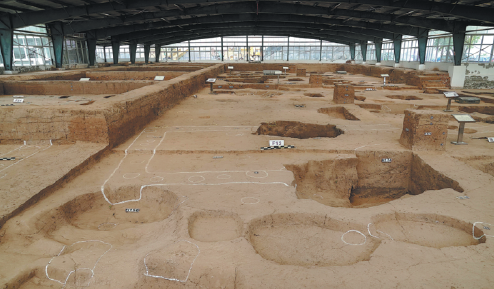Discovered ruins point to older civilization

Archaeologists recently unveiled newly discovered city ruins in Central China, which reveal an ancient state dating back 5,300 years.
The Zhengzhou municipal institute of cultural relics and archaeology announced on Thursday in the capital city of Henan province that the Shuanghuaishu site in Gongyi, on the outskirts of Zhengzhou, was the site of a "huge settlement". It was the highest-level residential complex ever found of its time along the middle and lower reaches of the Yellow River.
The remains of three huge moats, circling large-scale residential compounds in the center, rigidly planned public graveyards and terraces for religious sacrifices were found at the 1.17-square-kilometer site, according to the institute.
"This location was carefully chosen and its construction was well designed," says Wang Wei, president of the Chinese Society of Archaeology.
"Discoveries in Shuanghuaishu have filled a gap in the research of the origins of Chinese civilization."
The area where the Shuanghuaishu site is located, commonly known as Zhongyuan or the Central Plains, was traditionally recognized as a center of early-stage Chinese civilization.
Previous discoveries in Henan include Erlitou, which is generally considered to be the site of the capital of the Xia Dynasty (c. 21st century-16th century BC), Yinxu, the ruins of the last capital of the Shang Dynasty (c. 16th century-11th century BC), and several other major cities of the two dynasties-the beginning of China's united central kingship ruling a vast territory.
Academics had believed the area rose as a cultural hub about 4,500 years ago.
"By the Liaohe River (in Northeast China), and the central and lower reaches of the Yangtze River, we find high-level urban ruins which may be capitals of regional states (from about 5,000 years ago)," Wang says.
"Development of civilizations accelerated in these areas, but we had regretted that no such finding of the same period was made in the Zhongyuan area."
For example, the Liangzhu Archaeological Ruins in eastern Zhejiang province dating back 5,300 years showed a highly developed rice-breeding agricultural civilization that worshipped jade. It was inscribed as a UNESCO World Heritage site last year.
"We all know Zhongyuan is a core of ancient Chinese civilization, but how did it become the core?" he says. "We didn't have solid clues until now… In the golden age when civilization started in China, this site likely played a key role."
Some unearthed objects showed "the aura of kings" as Gu Wanfa, head of the Zhengzhou institute, points out.
A set of clay pots arranged like the Big Dipper was believed to represent nobility.
"The Big Dipper is a symbol of political rituals in ancient China," Gu explains. "A master of this city may borrow its meaning to enhance rulings."
He also believes the Big Dipper may represent people's religious beliefs at that time.
Other key findings include a silkworm statuette made of boar teeth.
The city's appearances and location echo some historical records in I Ching, an ancient Chinese classic.
According to Li Boqian, an archaeology professor at Peking University, the possibility of the city being the seat of Xuanyuan, a legendry king in early Chinese history, cannot be ruled out, but it is still too early to draw any conclusions.
"At least it shows a period of time when the earliest China was being incubated," Li says.
"As other types of civilizations like Liangzhu disappeared in history, the one of Zhongyuan has been continuous. Shuanghuaishu was the starting point of that uncut line."
Xinhua contributed to the story



Today's Top News
- Xi stresses key role of public opinion
- War-themed movies teach important lessons
- Xi urges studying, absorbing netizens' opinions in formulating 15th Five-Year Plan
- Yuan eyes greater role among safe-haven assets
- China set to clean up online health content
- China, EU can shape climate governance






























